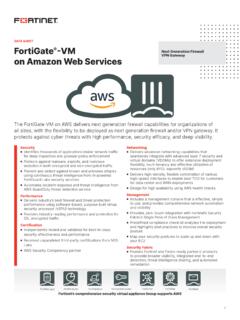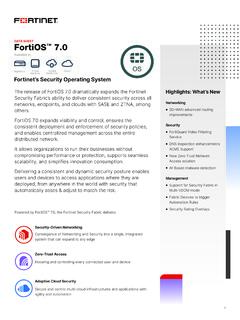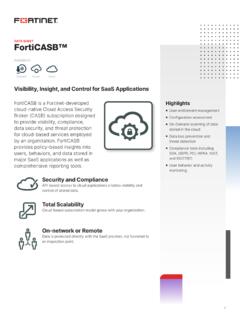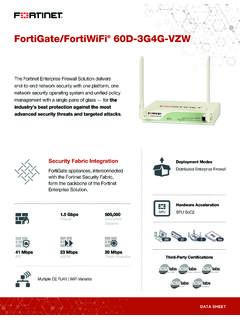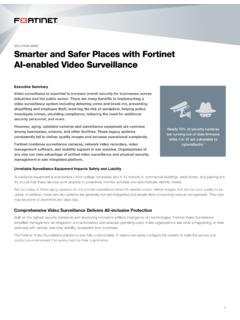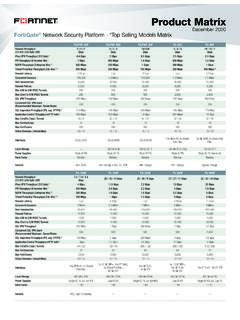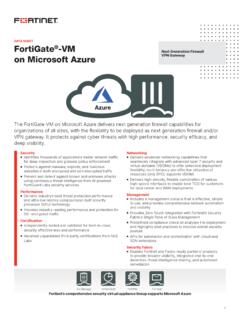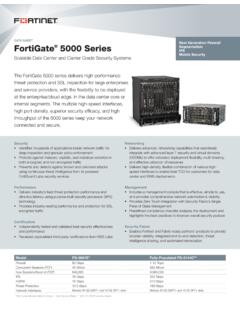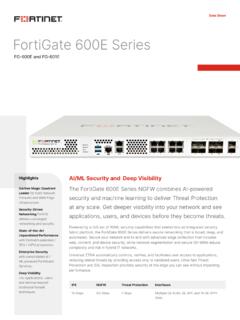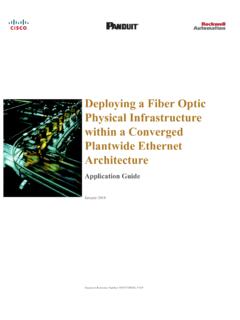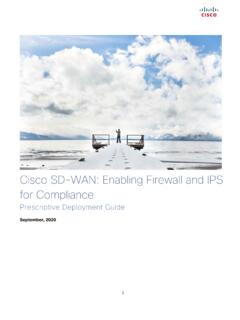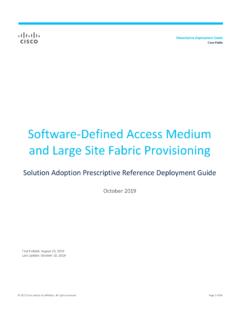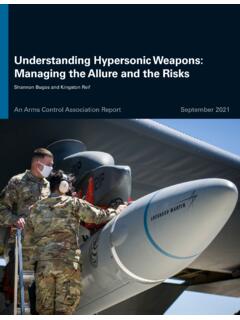Transcription of DEPLOYMENT GUIDE FortiGate and Microsoft Azure Virtual …
1 FortiGate and Microsoft Azure Virtual WAN IntegrationDEPLOYMENT GUIDE2 DEPLOYMENT GUIDE | FortiGate and Microsoft Azure Virtual WAN IntegrationTable of Contents 1. Microsoft Azure Virtual WAN Virtual WAN Architecture Creating the Azure Virtual Adding Virtual Network Connections to the Virtual WAN DEPLOYMENT of the Azure Virtual WAN ARM Prerequisites for the Storage account and ARM template DEPLOYMENT ..106. Associating the VPN Sites with the Virtual WAN Adding hub Validation ..1331. Microsoft Azure Virtual WAN IntroductionMicrosoft Azure Virtual WAN is an Azure -managed service that provides automated branch connectivity to, and through, Azure . You can leverage the Azure backbone to connect branches and enjoy branch-to- Virtual network connectivity. Azure regions serve as hubs that you can use to connect your branches to.
2 This GUIDE explains how to configure FortiGates to connect to the Azure Virtual WAN service. It also explains how to access Virtual networks in Azure and employ branch-to-branch connectivity. 2. Virtual WAN Architecture DiagramThe Azure Virtual WAN architecture consists of the following important resources: Virtual WAN. A Virtual WAN resource is a Virtual overlay of the Azure network. It contains resources that include all of the links to the Virtual WAN hub. Virtual hub. A Virtual hub is a Microsoft -managed Virtual network. The hub contains various service endpoints to enable connectivity from your on-premises network (vpnsite). There can only be one hub per Azure region. When a Virtual WAN hub is created from the portal, it creates a Virtual hub Virtual network (VNet) and a Virtual hub VPN hub gateway is not the same as a Virtual network gateway that is used for ExpressRoute and VPN gateway.
3 For example, when using Virtual WAN, you do not create a site-to-site connection from the on-premises site directly to the Virtual network. Instead, you will create a site-to-site connection to the hub, so the traffic always passes through the hub gateway. This means that your VNets do not need their own Virtual network gateway. Virtual WAN allows your VNets to take advantage of scaling easily through the Virtual hub and the Virtual hub VNet connection. The hub VNet connection resource is used to connect the hub seamlessly to the VNet. Only the Virtual networks that are within the same hub region can be connected to the Virtual WAN A site resource is used for site-to-site connections only. The site resource is vpnsite. It represents your on-premises VPN device and its settings. The Azure Virtual WAN architecture diagram below represents remote sites Tempe and Folsom, which connect to the Virtual WAN hub.
4 The hub Virtual network is connected to two VNets: B and C. Connecting to the Virtual WAN hub enables the sites Tempe and Folsom to access both VNets in Azure and to connect with each other through the Virtual WAN hub. There are redundant VPN tunnels from each branch to the Virtual WAN hub to enhance connectivity. Routing is handled by Border Gateway Protocol (BGP). Figure 1: FortiGate (s) and Azure Virtual WAN Virtual HubVNet CVNet BVNet AVNet ConnectionVNet Connection4 DEPLOYMENT GUIDE | FortiGate and Microsoft Azure Virtual WAN Integration3. Creating the Azure Virtual WANF irst, the Azure Virtual WAN hub needs to be created within your subscription via the portal: At this time, use of special characters or upper case letters is not supported for the name of the Virtual WAN and also the resource logged into the portal, click on Create a new resource and select Virtual WAN.
5 Once the required information such as the name, region, resource group, and the subscription are chosen, the Azure Virtual WAN creation process will be completed. Figure 2: Process flow diagram of Azure Virtual WAN integration with FortiGate (s).Create Azure Virtual WAN in Azure PortalCreate Virtual WAN hub in Azure portalIdentify and connect VNets to Azure Virtual WAN through VNet connectionsCreate storage account for to a blob storageDeploy the ARM template to deploy the automationTest and verify connectivity between the branch offices and between branch and VNets5 DEPLOYMENT GUIDE | FortiGate and Microsoft Azure Virtual WAN IntegrationYou can choose to enable branches to communicate with each other through the Virtual WAN hub at this stage. Select Network traffic allowed between branches associated with the same hub under following settings are used for site-to-site connectivity.
6 The gateway scale units can be chosen depending on the traffic next step is to create a new Virtual WAN hub. To create a Virtual WAN hub, navigate to Hubs and click on +New Hub to create a new hub. In the architecture discussed, site-to-site connectivity is used for connecting branch offices to the Virtual WAN hub through IPsec VPNs. It requires creation of a VPN gateway, which can be created when the hub is created. Point-to-site is for connecting end-user devices to the Virtual WAN hub using OpenVPN and other VPN clients. Similarly, if ExpressRoutes are to be connected to the Virtual WAN hub, an ExpressRoute gateway must be created. Since the architecture here only pertains to site-to-site connections, point-to-site and ExpressRoute gateway creation will be disabled. For advanced routing using the hub, routing tables must be set up.
7 In this example, routing using the hub is not used, so route tables do not need to be a Virtual WAN hub can take up to 30 minutes. 6 DEPLOYMENT GUIDE | FortiGate and Microsoft Azure Virtual WAN Integration4. Adding Virtual Network Connections to the Virtual WAN HubOnce the Azure Virtual WAN is created, the next step is to identify the customer VNets that need to be connected to enable end-to-end this example, there are two VNets, applicationvnet and security. To add them to the Virtual WAN hub, start at the Virtual WAN page. Navigate to the Virtual Network Connections tab, and click on Add connection to select the VNets that will connect to the Virtual WAN hub. 7 DEPLOYMENT GUIDE | FortiGate and Microsoft Azure Virtual WAN IntegrationOnce the VNets are connected to the Virtual WAN hub, they will appear as DEPLOYMENT of the Azure Virtual WAN ARM Prerequisites for the deploymentBefore the Azure Resource Manager (ARM) template can be deployed, the following prerequisites must be met: nnService principalnnDetails about the Virtual WANnnStorage blob that contains the fileService principal1.
8 Log into your Azure account. If you do not already have one, create one by following the on-screen Create a service principal, making note of the following items as they will be needed to deploy the Function App:nnTenant ID (used for the Tenant ID parameter). This is under Azure Active Directory > Properties > Directory ID. This is not required for the hybrid licensing ID (used for the Rest App ID parameter). This is under Azure Active Directory > App registrations > {your-app}.nnApplication secret (used for the Rest App Secret parameter). The application secret only appears once and cannot be about Virtual WANThe following information is needed about the Azure Virtual WAN service :nnVirtual WAN namennName of the resource is the main file that serves as the input for Azure functions. This contains the information about all of the sites that want to connect to the Azure Virtual WAN service.
9 This file is stored in a storage blob. The following information is required: nnName of the site (to be used as an identifier in Azure )nnPublic IP address of the FortiGatennInternal networks behind the FortiGate that need access to the Virtual WANnnThe BGP ASN and BGP peering IP address to usennVDOM nnLogin GUIDE | FortiGate and Microsoft Azure Virtual WAN IntegrationContents of a sample file format is shown below. Storage account and uploadOnce the file is populated, it needs to be uploaded to the Azure blob storage in a storage account. The following steps explain how to create a storage account and store the file in the blob storage. To create a storage account from the Azure portal, click on Create a resource, type storage account and select the storage account resource creation.
10 Click Create. In the following screen, select a Resource group, or create a new one. This is the location where the storage account will reside. A unique name for the storage account is required, as each storage account URL is unique. The other fields can be left as default. The replication can also be set to locally redundant in the Advanced and Tags sections can also be left as default. Click on Review + create to create the storage GUIDE | FortiGate and Microsoft Azure Virtual WAN IntegrationOnce the storage account is configured, navigate to the Blobs section of the storage account and create a container by clicking on +Container. Create a container that enables read access to the container is created, click on the container name, then click Upload to upload the the file and click GUIDE | FortiGate and Microsoft Azure Virtual WAN IntegrationOnce the file is uploaded, right click on the file and click on Blob properties.
